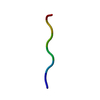[English] 日本語
 Yorodumi
Yorodumi- PDB-6m9i: L-GSTSTA from degenerate octameric repeats in InaZ, residues 707-712 -
+ Open data
Open data
- Basic information
Basic information
| Entry | Database: PDB / ID: 6m9i | |||||||||
|---|---|---|---|---|---|---|---|---|---|---|
| Title | L-GSTSTA from degenerate octameric repeats in InaZ, residues 707-712 | |||||||||
 Components Components | Ice nucleation protein | |||||||||
 Keywords Keywords | PROTEIN FIBRIL / amyloid / racemic / ice nucleation / MicroED / InaZ / pseudomonas syringae | |||||||||
| Function / homology | Bacterial ice-nucleation, octamer repeat / Ice nucleation protein repeat (2 copies) / Bacterial ice-nucleation proteins octamer repeat. / ice binding / cell outer membrane / Ice nucleation protein Function and homology information Function and homology information | |||||||||
| Biological species |  Pseudomonas syringae pv. syringae (bacteria) Pseudomonas syringae pv. syringae (bacteria) | |||||||||
| Method | ELECTRON CRYSTALLOGRAPHY / electron crystallography / cryo EM / Resolution: 0.9 Å | |||||||||
 Authors Authors | Zee, C. / Glynn, C. / Gallagher-Jones, M. / Miao, J. / Santiago, C.G. / Cascio, D. / Gonen, T. / Sawaya, M.R. / Rodriguez, J.A. | |||||||||
| Funding support |  United States, 2items United States, 2items
| |||||||||
 Citation Citation |  Journal: IUCrJ / Year: 2019 Journal: IUCrJ / Year: 2019Title: Homochiral and racemic MicroED structures of a peptide repeat from the ice-nucleation protein InaZ. Authors: Chih-Te Zee / Calina Glynn / Marcus Gallagher-Jones / Jennifer Miao / Carlos G Santiago / Duilio Cascio / Tamir Gonen / Michael R Sawaya / Jose A Rodriguez /  Abstract: The ice-nucleation protein InaZ from contains a large number of degenerate repeats that span more than a quarter of its sequence and include the segment GSTSTA. structures of this repeat segment, ...The ice-nucleation protein InaZ from contains a large number of degenerate repeats that span more than a quarter of its sequence and include the segment GSTSTA. structures of this repeat segment, resolved to 1.1 Å by microfocus X-ray crystallography and to 0.9 Å by the cryo-EM method MicroED, were determined from both racemic and homochiral crystals. The benefits of racemic protein crystals for structure determination by MicroED were evaluated and it was confirmed that the phase restriction introduced by crystal centrosymmetry increases the number of successful trials during the phasing of the electron diffraction data. Both homochiral and racemic GSTSTA form amyloid-like protofibrils with labile, corrugated antiparallel β-sheets that mate face to back. The racemic GSTSTA protofibril represents a new class of amyloid assembly in which all-left-handed sheets mate with their all-right-handed counterparts. This determination of racemic amyloid assemblies by MicroED reveals complex amyloid architectures and illustrates the racemic advantage in macromolecular crystallography, now with submicrometre-sized crystals. | |||||||||
| History |
|
- Structure visualization
Structure visualization
| Movie |
 Movie viewer Movie viewer |
|---|---|
| Structure viewer | Molecule:  Molmil Molmil Jmol/JSmol Jmol/JSmol |
- Downloads & links
Downloads & links
- Download
Download
| PDBx/mmCIF format |  6m9i.cif.gz 6m9i.cif.gz | 12.7 KB | Display |  PDBx/mmCIF format PDBx/mmCIF format |
|---|---|---|---|---|
| PDB format |  pdb6m9i.ent.gz pdb6m9i.ent.gz | 5.3 KB | Display |  PDB format PDB format |
| PDBx/mmJSON format |  6m9i.json.gz 6m9i.json.gz | Tree view |  PDBx/mmJSON format PDBx/mmJSON format | |
| Others |  Other downloads Other downloads |
-Validation report
| Summary document |  6m9i_validation.pdf.gz 6m9i_validation.pdf.gz | 357.6 KB | Display |  wwPDB validaton report wwPDB validaton report |
|---|---|---|---|---|
| Full document |  6m9i_full_validation.pdf.gz 6m9i_full_validation.pdf.gz | 357.1 KB | Display | |
| Data in XML |  6m9i_validation.xml.gz 6m9i_validation.xml.gz | 1.8 KB | Display | |
| Data in CIF |  6m9i_validation.cif.gz 6m9i_validation.cif.gz | 1.9 KB | Display | |
| Arichive directory |  https://data.pdbj.org/pub/pdb/validation_reports/m9/6m9i https://data.pdbj.org/pub/pdb/validation_reports/m9/6m9i ftp://data.pdbj.org/pub/pdb/validation_reports/m9/6m9i ftp://data.pdbj.org/pub/pdb/validation_reports/m9/6m9i | HTTPS FTP |
-Related structure data
| Related structure data |  6eexC  6m7mC  6m9jC C: citing same article ( |
|---|---|
| Similar structure data | Similarity search - Function & homology  F&H Search F&H Search |
- Links
Links
- Assembly
Assembly
| Deposited unit | 
| ||||||||
|---|---|---|---|---|---|---|---|---|---|
| 1 |
| ||||||||
| Unit cell |
|
- Components
Components
| #1: Protein/peptide | Mass: 522.508 Da / Num. of mol.: 1 / Fragment: UNP residues 707-712 / Source method: obtained synthetically / Details: L-GSTSTA Source: (synth.)  Pseudomonas syringae pv. syringae (bacteria) Pseudomonas syringae pv. syringae (bacteria)References: UniProt: P06620 |
|---|---|
| #2: Water | ChemComp-HOH / |
-Experimental details
-Experiment
| Experiment | Method: ELECTRON CRYSTALLOGRAPHY |
|---|---|
| EM experiment | Aggregation state: 3D ARRAY / 3D reconstruction method: electron crystallography |
- Sample preparation
Sample preparation
| Component | Name: L-GSTSTA from ice nucleation protein inaZ / Type: COMPLEX / Entity ID: #1 / Source: NATURAL |
|---|---|
| Source (natural) | Organism:  Pseudomonas syringae pv. syringae (bacteria) Pseudomonas syringae pv. syringae (bacteria) |
| EM crystal formation | Details: Batch Mode: 0.1 M McIlvaine, pH 4.2, 12.5% w/v PEG8000, 0.1 M sodium chloride Temperature: 298 K |
| Buffer solution | pH: 4.2 |
| Specimen | Embedding applied: NO / Shadowing applied: NO / Staining applied: NO / Vitrification applied: YES |
| Specimen support | Details: unspecified |
| Vitrification | Cryogen name: ETHANE |
-Data collection
| Experimental equipment |  Model: Tecnai F20 / Image courtesy: FEI Company | ||||||||||||||||||||||||||||||||||||||||||||||||||||||||||||||||||||||||||||||||||||||||||||||||||||||||||||||
|---|---|---|---|---|---|---|---|---|---|---|---|---|---|---|---|---|---|---|---|---|---|---|---|---|---|---|---|---|---|---|---|---|---|---|---|---|---|---|---|---|---|---|---|---|---|---|---|---|---|---|---|---|---|---|---|---|---|---|---|---|---|---|---|---|---|---|---|---|---|---|---|---|---|---|---|---|---|---|---|---|---|---|---|---|---|---|---|---|---|---|---|---|---|---|---|---|---|---|---|---|---|---|---|---|---|---|---|---|---|---|---|
| Microscopy | Model: FEI TECNAI F20 | ||||||||||||||||||||||||||||||||||||||||||||||||||||||||||||||||||||||||||||||||||||||||||||||||||||||||||||||
| Electron gun | Electron source:  FIELD EMISSION GUN / Accelerating voltage: 200 kV / Illumination mode: FLOOD BEAM FIELD EMISSION GUN / Accelerating voltage: 200 kV / Illumination mode: FLOOD BEAM | ||||||||||||||||||||||||||||||||||||||||||||||||||||||||||||||||||||||||||||||||||||||||||||||||||||||||||||||
| Electron lens | Mode: DIFFRACTION | ||||||||||||||||||||||||||||||||||||||||||||||||||||||||||||||||||||||||||||||||||||||||||||||||||||||||||||||
| Image recording | Electron dose: 0.01 e/Å2 / Film or detector model: TVIPS TEMCAM-F416 (4k x 4k) | ||||||||||||||||||||||||||||||||||||||||||||||||||||||||||||||||||||||||||||||||||||||||||||||||||||||||||||||
| EM diffraction | Camera length: 1156 mm | ||||||||||||||||||||||||||||||||||||||||||||||||||||||||||||||||||||||||||||||||||||||||||||||||||||||||||||||
| EM diffraction shell | Resolution: 7.27→0.9 Å / Fourier space coverage: 86.4 % / Multiplicity: 4.3 / Num. of structure factors: 1747 / Phase residual: 1.0E-10 ° | ||||||||||||||||||||||||||||||||||||||||||||||||||||||||||||||||||||||||||||||||||||||||||||||||||||||||||||||
| EM diffraction stats | Details: Phase statistics are not applicable. No imaging was used. The phases were obtained using a crystallographic direct methods program, SHELXD. Fourier space coverage: 86.4 % / High resolution: 0.9 Å / Num. of intensities measured: 7494 / Num. of structure factors: 1750 / Phase error: 0 ° / Phase residual: 1.0E-10 ° / Phase error rejection criteria: not applicable / Rmerge: 16.2 / Rsym: 16.2 | ||||||||||||||||||||||||||||||||||||||||||||||||||||||||||||||||||||||||||||||||||||||||||||||||||||||||||||||
| Detector | Date: Sep 24, 2017 | ||||||||||||||||||||||||||||||||||||||||||||||||||||||||||||||||||||||||||||||||||||||||||||||||||||||||||||||
| Radiation | Scattering type: electron | ||||||||||||||||||||||||||||||||||||||||||||||||||||||||||||||||||||||||||||||||||||||||||||||||||||||||||||||
| Radiation wavelength | Relative weight: 1 | ||||||||||||||||||||||||||||||||||||||||||||||||||||||||||||||||||||||||||||||||||||||||||||||||||||||||||||||
| Reflection | Resolution: 0.9→7.271 Å / Num. obs: 1760 / % possible obs: 85.5 % / Redundancy: 4.269 % / Biso Wilson estimate: 42.62 Å2 / CC1/2: 0.99 / Rmerge(I) obs: 0.162 / Rrim(I) all: 0.185 / Χ2: 0.962 / Net I/σ(I): 5.5 / Num. measured all: 7513 / Scaling rejects: 1 | ||||||||||||||||||||||||||||||||||||||||||||||||||||||||||||||||||||||||||||||||||||||||||||||||||||||||||||||
| Reflection shell | Diffraction-ID: 1
|
- Processing
Processing
| Software |
| |||||||||||||||||||||||||||||||||||||||||||||||||||||||||||||||
|---|---|---|---|---|---|---|---|---|---|---|---|---|---|---|---|---|---|---|---|---|---|---|---|---|---|---|---|---|---|---|---|---|---|---|---|---|---|---|---|---|---|---|---|---|---|---|---|---|---|---|---|---|---|---|---|---|---|---|---|---|---|---|---|---|
| EM software |
| |||||||||||||||||||||||||||||||||||||||||||||||||||||||||||||||
| EM 3D crystal entity | ∠α: 90 ° / ∠β: 90 ° / ∠γ: 90 ° / A: 9.19 Å / B: 11.89 Å / C: 22.43 Å / Space group name: P212121 / Space group num: 19 | |||||||||||||||||||||||||||||||||||||||||||||||||||||||||||||||
| CTF correction | Type: NONE | |||||||||||||||||||||||||||||||||||||||||||||||||||||||||||||||
| 3D reconstruction | Resolution: 0.9 Å / Resolution method: DIFFRACTION PATTERN/LAYERLINES / Symmetry type: 3D CRYSTAL | |||||||||||||||||||||||||||||||||||||||||||||||||||||||||||||||
| Atomic model building | Protocol: AB INITIO MODEL / Space: RECIPROCAL / Target criteria: maximum likelihood | |||||||||||||||||||||||||||||||||||||||||||||||||||||||||||||||
| Refinement | Resolution: 0.9→0.9 Å / SU ML: 0.05 / Cross valid method: THROUGHOUT / σ(F): 1.45 / Phase error: 20.67
| |||||||||||||||||||||||||||||||||||||||||||||||||||||||||||||||
| Solvent computation | Shrinkage radii: 0.9 Å / VDW probe radii: 1.11 Å | |||||||||||||||||||||||||||||||||||||||||||||||||||||||||||||||
| Displacement parameters | Biso max: 3.94 Å2 / Biso mean: 1.169 Å2 / Biso min: 0.13 Å2 | |||||||||||||||||||||||||||||||||||||||||||||||||||||||||||||||
| Refinement step | Cycle: final / Resolution: 0.902→7.271 Å
| |||||||||||||||||||||||||||||||||||||||||||||||||||||||||||||||
| Refine LS restraints |
| |||||||||||||||||||||||||||||||||||||||||||||||||||||||||||||||
| LS refinement shell | Refine-ID: ELECTRON CRYSTALLOGRAPHY / Rfactor Rfree error: 0 / Total num. of bins used: 8
|
 Movie
Movie Controller
Controller


 PDBj
PDBj

